Fiddle Leaf Fig Drooping After Repot/Root Pruning- Help!
So I put a big long post asking for advice but put it in the container gradening forum by accident.
Long story short, I put my fiddle into terrible soil after getting him, didn't put him in enough light, watered in "sips", and didn't repot but potted up and this resulted in Oedema within a month. Fungus gnats also appeared.
After some advice from Al and Dave, and reading more articles, made the decision to get him out of his soil ASAP to try and prevent further damage to the roots and put him into a mix I found here, and to trim the root ball as well.
Yesterday I mixed together a mix that was 40% Gardening soil, 40% reptibark, and 20% perlite.

We sifted the bark and perlite too so that no super fine material was left

I just used a kitchen strainer from wal mart since no local places carried a sieve.
After mixing, I did as much research as I could to ensure that the transplant and root pruning went smoothly. I'm a newb though so was quite nervous, that is until we lifted Sid (name we gave our fiddle) out of his pot and saw A) how root bound he was and B) how the outside/top of the soil was bone dry but bottom was clumpy thick and wet and smelt awful.
So, thus began the process.
First we removed him and brought him outside. As you can see he was incredibly root bound from years of never being repotted at the nursery
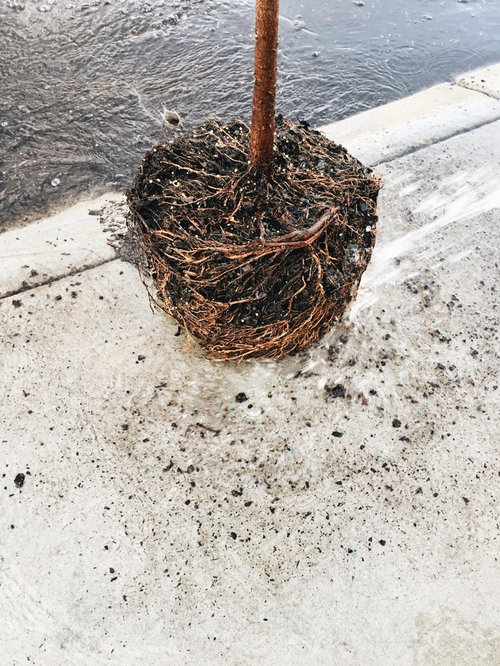
my first question would be- it was hard to tell which roots were dead from root rot or not. He had several white roots, but most were this tan/brown color. Some larger ones were black but were woody and thick- does that mean they're dead or just old?
Anyways. We sprayed him off and I made sure to keep the roots wet the entire time to avoid losing super fine ones. I went and cut slits in the side and just worked on teasing it all out so we could clear out all the old soil.
We had been at it for 2 hours and finally we got down to this

We ended up bringing this part into the bathtub with us where I placed it into room temp water (was afraid the cold hose any more would shock him) and teased more out.
After all soil had been removed and I had trimmed as many dead roots as I could recognize, we placed him into a slightly smaller and brand new pot with the new mix
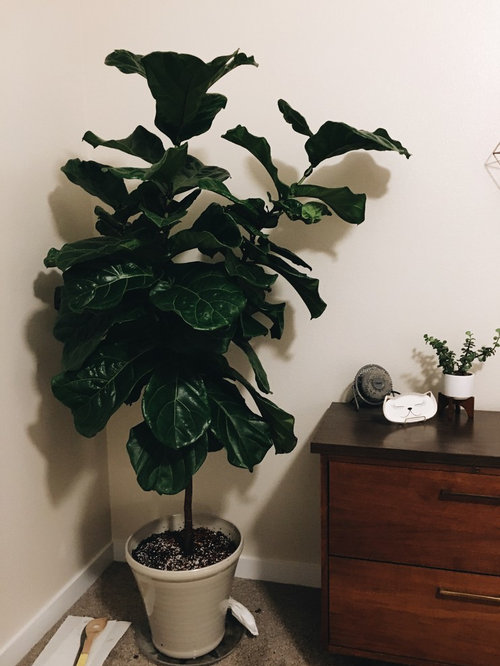
I made sure to put some soil at the bottom, then placed him in and then filled it in and also shook the pot a bit to ensure soil filled all the cracks.
I then hen ran water into the pot, waited, then ran some more in until it drained to the bottom. We let it drain, then tipped him at a 45 degree angle and drained some more. The I ran some water in with a little less than the recommended dose with miracle gro fertilizer (3-1-2 ratio) and then went to bed.
Sadly the repotting took way longer than I expected, so I was nervous we were not done with everything until 10:30.
This morning he seemed to be doing okay
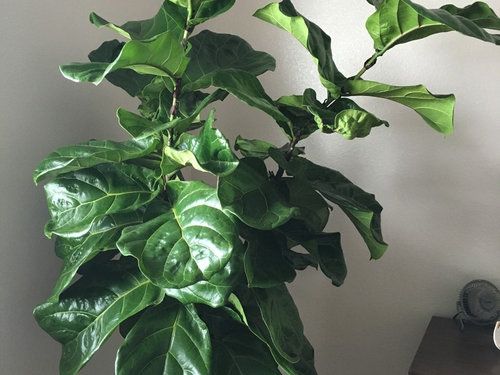
But now at 7:30 (I live in Idaho in PNW) he seems to be getting droopier and I'm getting worried. Any advice? I trimmed off some of the more infected leaves but they were small... Should I do more pruning because I'm worried maybe this is too many leaves for the trimmed root ball to support? Did I mess up in this process at all? I just want to try and avoid having to do a full prune and losing all these beautiful leaves...
Droopiness by this evening

TIA
Comments (64)
Makayla Madden
Original Author6 years agoOkay, I think the 8oz was volume of the reptibark and not weight! Same with the perlite and soil... But I will double check when I'm at the store!
Makayla Madden
Original Author6 years agoEither way, when I sifted everything I scooped up everything in cups and measured it out to make sure that I went by volume :)
Related Discussions
Fiddle Leaf Fig Drooping and Turning Yellow - Help (pics included)
Q
Comments (2)And move it in front of the window too. It's not getting any light where it is and likely shedding leaves. but yes, try house plants. Your fig is not edible....See MoreFiddle Leaf Fig FLF Droopy after 5-1-1 soil repot - will it make it?
Q
Comments (19)Pictures would help a lot; include the whole plant and one of the pot and soil. What did you do when you put it in the 17 inch pot? Put the existing rootball in the pot and surround it with fresh soil or remove the old soil and replace it? What kind of soil was it in and what kind of fresh soil was it? Was it rootbound? It's possible the new pot is too big, making the soil stay very wet for too long, causing roots to suffocate for lack of air to pull oxygen from. If so, the easiest remedy would be to put it back in the old pot and wait until June to repot in a faster draining highly aerated soil that would be harder to overwater. Meanwhile, check out the posts upthread about watering, using a dowel to check soil moisture, and the kinds of soil and light conditions lyratas do best in, and start to water only when the soil at the bottom is the pot is dry. Lenore...See MoreHELP: Droopy Fiddle Leaf Fig After Repotting
Q
Comments (0)I have a [post [(https://www.houzz.com/discussions/need-advice-with-flf-dsvw-vd~5384107)prior to this which I wrote to ask some questions before I repotted my Fiddle Leaf Fig. Asking for help because after repotting, my plant now looks sad and the leaves became droopy, and I don't know if I should be doing something right now. Here's a photo of the plant immediately after repotting and how it is now: I have no photo of the roots when I repotted it but it took me more than 2 hours to detangle them using both chopstick and water (jet). I tried to use the 511 mix for the new pot: Please help :(...See Moreis my fiddle leaf fig dying after repotting?
Q
Comments (5)with browning leaves.. it was previously stressed ... so you stressed it more with repotting ... you are going to have to just let it settle down and see what happens in the next 4 to 6 weeks ... and in the meantime.. just water it properly ... it may lose all its leaves.. but there may be a good chance.. if the repotting solved some issue.. that it can releaf im wondering why you didnt up pot ... or if you did.. how small the previous pot was ......See MoreMakayla Madden
Original Author6 years agoAlright, repot done! With a ratio of 5:1:1, perlite and bark sifted so no dust or small particles.
Here is the new soil
- Makayla Madden thanked tapla (mid-Michigan, USDA z5b-6a)
Makayla Madden
Original Author6 years agoUpdate:
The Oedema doesn't seem to be spreading since the new new soil, but he doesn't seem to be doing crazy better either. He seems droopier and looks like he will be losing his bottom leaves. Is there anything I should do, or just wait this out as he decides what leaves he cannot handle while he recovers from root rot/multiple potting/transplant shock?


sypndrank
6 years agolast modified: 6 years agoCould always toss a cheap daylight CFL light above it for a little bit? I always do that after bring new stuff home I re-potted, or just repotting but I'm a noob like you so I can't say it will help but I would figure more light the better.
My bulb is those Feit daylight 40 watt cfl equivalent to 150 watts they are 6500k and a whopping 2,800 lumens, on a timer for 8 hours. That within a foot of the plant seems to do wonders for me! But again, I'm a noob :P
Do you let the water sit out to get rid of excess chlorine I know in Kansas our water is pretty harsh. Rain water always seems to help, but again not everyone can collect and harvest it. I just added a 500 gallon IBC tote connected to the gutter this year!
I hope things perk up to normal, beautiful plant! I feel your sorrow, I hate when this happens!
Makayla Madden
Original Author6 years agoSo he seems to be doing well! I have enjoyed this journey as heartbreaking as its been since it has taught me a lot about patience and caring for plants properly.
I do do have one concern left- he has let go of all his leaves he cannot handle and we have placed him by lots of light! I did even see a couple new shoots growing on his roots when I pulled the soil back a bit.
Howveer one of the stems where I pruned him back is now turning brown and mushy- why is this? Could it spread?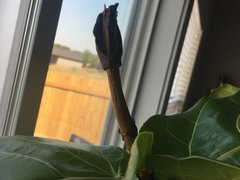
tapla (mid-Michigan, USDA z5b-6a)
6 years agoBrown mushy stems are usually the result of any of several species of fungi infecting roots and moving systemically into tissues in the root to shoot transition zone or even more distal to that. By far, the most predominant cause would be over-watering/soils that remain saturated for extended periods, providing the anaerobic conditions favored by the fungaluglies.
Yes, it could easily spread, in large part because saturated soils can severely limit the plant's vitality/metabolism. Since the plant's natural ability to defend itself against herbivory and diseases is a byproduct of the plant's metabolic processes, anything that limits metabolic functions leaves the plant more vulnerable.
Al
robin98
6 years agoAl, can you get brown mushy stems like above from infected pruning cuts? Or is it much more likely to happen from the roots then upwards?
Makayla Madden
Original Author6 years agoThat's what I'm wondering- with this new 5-1-1 mix, It seems to be doing a much better job at draining water and allowing roots to breathe/grow, so I was hoping my fiddle wouldn't be sitting in water or still dealing with root rot. None of the leaves are showing more signs of Oedema either, and in my experience with root rot it always started from the roots upward vs this where it's at the top. Could it be an infected cut? If so, what actions should I take?
Ekor Tupai
6 years agolast modified: 6 years agoWow,.. that was so intensive changes just in a half month. In every repotting process, root hairs must be broken since they're very small and need several days to regrow. That was twice root hair try to grow and abborted. Many energy wasted. At worst case when energy deposit almost empty, the plant decide not to support it's main stems and choose to grow new stem closest to the roots system to speed up nutrients upward - photosintesis cycle in order to build root hair as soon as possible. Big stem can be stuck on growth or dying on that case. Any rot that happen is natural for dead part of living thing in moist condition. All fungi are aerob obligate, they need oxygen to live, except yeast, so rotten root previously isn't fungi's responsible, and that mushy brown stem could be just bacteria that eat dead part of your tree.
Makayla Madden
Original Author6 years agoAn update on our Sid:
since repotting in the 5-1-1 (TRUE 5-1-1) mix, our Sid seems to be doing much better!
We moved him from our bedroom into our kitchen space after the 2nd repot in July to make sure he gets plenty of light. It was nerve wracking waiting, but as of this month he is way perkier, and has been growing new fine roots that are white and healthy as can be! He's also been consistently taking up his water in exactly 2 weeks- I've been keeping an eye on him to see as he gets stronger and starts pushing new growth, if that period will shorten at all.Here he was right after we had repotted him (July 21st) and then earlier this week!
the stem I had pruned back (see above comments) that seemed to possibly be infected stopped at the following leaf scar and hasn't spread, so no concerns there either.
Here is an example of the new roots he's been putting out. Happy day!
 What seems to possibly be new growth above where he lost one of his lower leaves... Guess we will wait and see!
What seems to possibly be new growth above where he lost one of his lower leaves... Guess we will wait and see!
I'd also like to say that I have moved nearly all of our plants into the 5-1-1 mix and I can't believe how much easier I can breathe knowing they are not water logged. All of them are thriving and flourishing after their repots! And I'm no longer fighting to keep roots healthy. I can water properly and know that they have air and drainage.
Thank you you to Al, and Dave, and everyone else! This has been such a learning experience and I'm so happy our beautiful fiddle didn't die on us and still looks very full and well!Len M
6 years agoHello Al, Dave, Makayla and fellow gardeners my name is Len and I am so very fortunate to have found GW through my favorite interior design website, Houzz. As a houseplant novice desperately longing to become a great and knowledgeable hobby grower I've turned to this Container Gardening forum to help lead and guide me through what should be the joys of nurturing and growing up my new precious babies. (As Al would say, I'll touch on this a bit later). It has provided me with a wealth of useful information that has piqued my interest in the hobby even more, and Al's writings and teachings have given me more reason to lie awake in bed until the very wee hours of the morning with great anticipation of what will I learn next! Not to mention, all of my fellow enthusiasts who aren't intimidated to share their experiences & post questions have given me courage to give growing a try. For all these things I am incredibly grateful. Thank you.
Back to the joys.... Oh the joys :-( Well, I sat on the floor in a puddle of tears (literally) a couple of days ago before flying out to work, (I'm a Flight Attendant so am usually away from home for 3 days at a time) because I was forced to leave my beloved Fürguson (a handsome & vivacious Ficus Lyrata recently purchased at a nursery near my house in CO) suffering at home alone. He was wilting sadly on the top, and curling up in grayish-green & brown anger on the bottom for being (what I think) "water-boarded" the day before. And to add insult to injury, I watered him AGAIN before leaving for work b/c I was duped into believing his wilting meant he was thirsty and my new potting soil was bone dry down to the bottom of the new 12" pot I placed him in. :-(
So if I may, I'll start from the beginning so that I can hopefully get the specific help I need from an expert, as I think I have had a very similar experience to the one Makayla has had....
Fürguson before the repotting: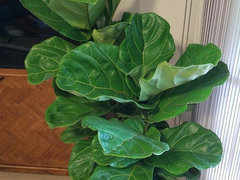
Fürguson seemed to be thriving in his grow pot of nursery potting soil when I purchased him about a full week & a half ago. He had a great amount of large perky leaves that had no visible signs of ailment and even sprouted 2 new leaves on the top of one of his 2 stems in the time of living in his new home. I never watered him until the repotting the other day, as the skewer showed damp when placed all the way to the bottom of the grow pot each time checked. I honestly was afraid to even touch him before thoroughly researching the appropriate way to care for his needs. So after countless hours of reading about soil, water movement, aeration, photosynthesis, root development, potting up & repotting, etc., I knew it would be more than beneficial for Fürguson to get re-potted into Al's gritty mix. So I set out & purchased Manna Pro Poultry Grit, Turface MVP, and uncomposted Pine Bark fines size small that I ultimately was not able to use because it was much too large, so I purchased 4 packages of the 4oz size Repti Bark at Petco at the last minute and was only able to let it soak for about 2-3 hours before the repotting. I built 3 different size screens - 1/16" insect screen to sift the Turface on, an 1/8" galvanized mesh screen for sifting the Poultry grit & a 1/4" garden screen for the for bark.
This is what it looked like...Notice the small pieces of Turface that seemed only slightly larger than 1/16"

I then brought Fürguson outside where the temperature was apx. 82°F & partly cloudy and began repotting. (It's been in the mid to upper 80's the past 2 weeks) I noticed that he had very long, thin encircling roots on the very top of the soil and I was able to easily pull him out of his 10" grow pot with all soil intact. There were very little visible roots showing through the outside perimeter of the soil ball and none that I saw growing underneath the base of the soil. I started from the very bottom, gently crumbling away the old moist soil working my way up to the roots of the tree in the middle. It took no time to expose all the roots, which surprisingly weren't many, and as far as I could tell breakage of the finer roots while removing the soil was very, very minimal. Once all was exposed I was able to quickly & easily detangle the roots. This is when I noticed that the stem on the left with the 2 newest sprouted leaves on top looked as tho it may have been grown in a plug(?) pot. The thicker lignified roots were severely curved upward toward the stem (j-hooked?), as though they had been made to grow in a tall, small cylindrical cup then longer thin fibrous roots branch out from them. The 2nd stem on the right had thick roots growing out horizontally and straight down from the main stem, and long fibrous roots were growing from the thicker ones as well as from the main stem itself.
Both individual tree roots before watering. Notice the very long skinny dried out, dead looking roots that were growing in a circle above the soil. I only cut them back about 6 inches. Are they dead and should I have cut them off completely right up to the stem?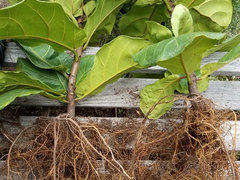
Close up of tree on the left after washing the roots clean. Notice the lignified j-hooked roots:

Tree on the right after washing the roots clean. The thicker roots on this tree are growing out horizontally from the stem and 2 of them growing straight down from the center of the stem: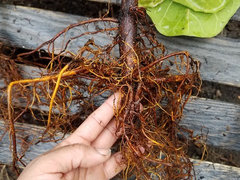
I turned the water hose on the shower setting and spray washed away ALL of the old soil compacted between the larger roots - because of my self diagnosed OCD, I feel now in hindsight, that I may have used an excessive amount of water to bare the roots of all the old soil. Not knowing at all what I was doing, I snipped back only the longest circling roots up to where I thought the living tissue began (about 6 inches up), then snipped the ends of the longest hanging thin roots (about 2 inches) to make it pretty even. I felt I needed to correct the lignified j-hooked roots by amputating them but I was afraid to even attempt that because again I have NO idea what I'm doing and the last thing I want to do is kill my beautiful new baby. :-( So I just planted the bare roots into the newly made gritty mix, gave him a good watering until the water ran clear through the bottom of the new 12" pot, and then wiped each of his leaves with a soft damp towel to help him take in as much sunlight as possible going forward. (He was extremely dusty, dirty & spotty from living in the nursery.)
Once I was done the sun was setting and the temperature had dropped a bit and was slightly breezy. The top 2 leaves only on both of the stems were wilting quite a bit so I opted to take him upstairs to the warmest room in the house and opened the blinds fully to receive East facing sunlight 1st thing in the morning. When I woke up I took Fürguson back downstairs to his usual spot in the dining room in front of a large West facing window and that's when I noticed the grayish-green curled up leaves that were browning around the edges on the very bottom of his stems. The petioles felt very weak and looked dark brown as well. The top 2 leaves on each stem were still very flaccid and overall Fürguson was drooping.
After the repotting:
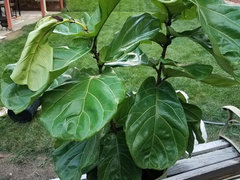
Following morning before work - Close up of the grayish-green browing dried out bottom leaves, and photo of flacid tops. (Sorry, I failed to snap a picture of the overall tree evidently):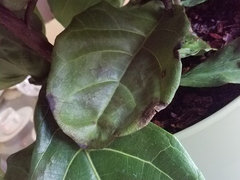
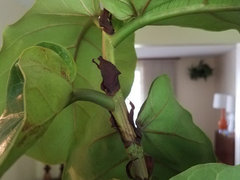
I burst into tears...
I understand the stress repotting causes but I have some serious concerns outside of that...
1) When I washed away the old soil from the roots I sprayed the very bottom of the stems right where the large roots began to branch out. Is it possible that I caused permanent damage by spraying the water too far up the roots & perhaps should have only focused the water on the small thin roots on the ends of the root ball? I ask b/c I received a Lyrata cutting once and I placed it in a cup of water to root. Every few days I'd spray the end of the branch/stem clean w/ water (again, my OCD rearing its ugly head :-( ) and then place it into fresh water. Well, all the leaves curled up in that grayish-green w/ brown edges and all but one fell off. I later learned it's best not to wet the leaves themselves so I figured watering up the stem might not be good for this species either. I didn't think it would be a problem when repotting since I needed to keep the roots moist and remove all the old soil, but after reading what Oedema is to plants I believe I may have water-boarded my Fürguson :(
See the thicker roots looking black now closer to the stem. I just thought they appeared darker due to them being wet, but after researching oedema I've learned that over watered roots will turn black...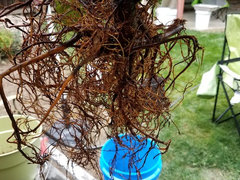
2) If I did indeed go too far with the over watering, how can I reverse these ill effects? Or is this damage really permanent?
3) Al, I know that you've explained in several teachings the benefits of root pruning, especially paying close attention to cut back the thicker lignified roots and correct those that are deformed. You even suggested to Makayla to do the same with her beloved, Sid. Should I cut back completely/amputate the thick J-hooked roots on the plant on the left and also cut away the thick roots growing outward & straight down on the tree stem on the right (see above photos) I'm afraid if I do Fürguson will be left with very little fine roots to support even half of his foliage. But if it's best for him that I do so I am totally up for the task!
4) Speaking of his foliage - If I do amputate those thicker roots how far down his stem should I prune off the top? If I do prune the 2 stems will it force branching? How can I prevent that if I just prefer him to grow tall and straight with lots of lush foliage from bottom to top, just like he is currently? If I do need to prune can you give me exact coordinates of where to make the cut, i.e.; 1/4" above a leaf facing away from the inside of the tree, or in between two leaves on the internode of the stem, etc.? (Because I really have no idea how leaves/stems/branches actually grow out from a plant or tree so I'm completely clueless on where to prune anything to encourage healthy growth or even discourage branching, etc.)
5) The gritty mix & the new pot - It seemed like my gritty mix had smaller Turface particles than Al's shown in another post. (See below comparison shots) I screened it over insect screen only and kept what didn't fall through but I seem to have many small pieces between 1/16" and 1/8". Should I re-screen using the 1/8" screen to remove those smaller particles? Also, I felt like the mix was quite heavy in the new larger 12" pot... Are the roots getting crushed underneath all that weight? And since I revealed so little roots on the trees should I have just repotted back into it's original 10" grow pot...or perhaps an even smaller pot if amputation & pruning of the lignified and thinner roots are required? Lastly on the new soil; As mentioned earlier, it was very dry the following day all the way down to the bottom of the pot. Is it because I failed to soak the bark for 24 hours prior? Or does it seem like my particle sizes are the culprit for drying it out so quickly?
6) I'm on day 3 of my trip so am flying home now. If I find that Fürguson has dropped the grayish-green & brown dried out leaves on the bottom how can I encourage them to grow back so that he isn't bald on the bottom of his stem above the top of the pot?
I have another 3 day trip starting tomorrow and then off for 3 days afterwards - should I plan on making all of these corrections when I return home since the weather forecast in Denver will be sunny with temperatures ranging from a high of 86°F-92°F every day next week?
I know this was quite a lot but I really truly want to learn and succeed in caring for all kinds of indoor houseplants, as I also purchased a beautiful Ficus Elastica, a large, lush Epipremnum Aureum (aka Golden Pothos/Ivy), and a ZZ plant that all need proper nurturing. At this point I do feel quite defeated, deflated, discouraged & dismayed :(
I thank everyone in advance for your time and responses. I pray you all have a lifetime of happy growing...I know at some point I'm bound to have the same.
Sincerely,Len
robin98
6 years agoLen, don't be too down! Of all your plants this one is the trickiest, if that's any consolation. How was he when you got home?
Len M
6 years agoThanks so much for the reassuring words, Robin. I have to say that I am much better today than I was when I left out for work on my last trip. I returned home last night to find Fürguson was not as bad as I imagined he'd be. His leaves at the bottom of both stems were dry, curled up and pretty much dead. Some of his larger leaves had brown spots and he was drooping extremely badly....To the point where I'm wondering if his petioles will ever rebound & lift his large heavy leaves back up? Also, his stem seemed a little shriveled from midway down & the greener part of the stem toward the top was quite soft. Last thing I noticed was the soil was SOOOO dry almost throughout. Of course I refrained from watering him, but I do wonder if this is normal for the gritty mix or is it b/c I failed to soak the bark for an adequate amount of time?
I sure hope to receive answers and advice soon. I'll sit tight until then. In the meantime here are the photos I took of him before flying out this morning...
Not as brown & shriveled as I thought he would be...
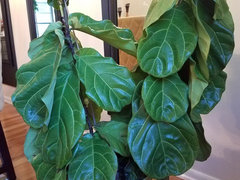
Dead looking shriveled bottom leaves :(
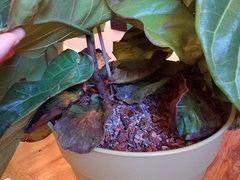
Some browning on the larger leaves...
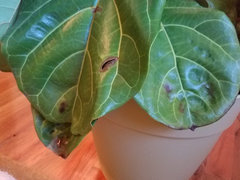
The 2 new leaves that sprouted on top of the stem w j-hooked roots. Still very flacid. They're being supported by a branch I found in my backyard & I wrapped the limp new leaves with one of the only leaves that had broken off from the bottom of my Fiddle during the repotting.
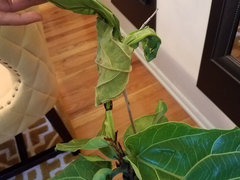
Again, thank you, Robin for taking the time to show interest in my Fiddle's well being.Len
Ekor Tupai
6 years agolast modified: 6 years agoYeah, seem good enough for plant that just got extreme root pruning. For healthy tree, i don't clean soil on the rootzone since too many root hair in there. I just fix root position and cut only the root that extremely circling, so after repot, no need to wait till it rebound to it's normal condition.
On your case, the tree need to regrow root and root hair, so it will need more time to metabolism normally. During developing root, the leaves will suffer since no suply energy for them so some will fall. In extreem, it will reduce stems so only few inches of the trunk above the ground that it keep alive, with new buds as old stem replacement.
On your case i ussualy give foliar feeding since root still unable to give nutrients for the leaves. Only few absorbed, but it's better than none.
robin98
6 years agoYou're very welcome. I'll try to give you some advice, but first off have to say I've never made or used gritty, hopefully someone experienced with that will chime in to help you. And I'm a bit useless with the root pruning - I had to smile when I read that part, because that's pretty much what I do : trim the long roots straight across the bottom but chicken out of doing anything major!
It will be a week in the new mix by the time you get back, so I wouldn't pull it out again. He'll have been putting energy into growing new fine root hairs, and you'll just set that process right back again, making it harder to recover. It sounds it was best to change the old mix, if it was staying wet that long. That would have been trouble in winter. I'd let it recover now, get through winter, build up some energy reserves in spring then repot with more thorough root pruning in summer.
I'd also suggest using 511 for the soil mix as it retains a bit more water (while still being aerated) which gives you more leeway than gritty. If it gets hot where you live in summer, and your job takes you away for a few days at a time, you might find the gritty dries out too fast.
Right for now its care will be a bit different, while it's recovering. Put it in a warm bright spot, out of direct sun or drafts. Keep its roots moist while it is re-establishing (my understanding of gritty is that the top levels dry out pretty fast so you might need to water more often and/or put something on the surface to keep moisture in the upper levels, correct me people if I'm wrong...)
Usually you're not supposed to fertilise until you see new growth, but that also might be different with gritty. New growth means roots have regrown and now energy can be directed to the leaves. When you see this move it to more sun and let it dry out more in between waterings. I wouldn't cut any leaves just yet. Hope some of that helps :)
Len M
6 years agoRobin all of this helps tremendously! At least it gives me a bit more direction on what to do right now. I was also thinking to maybe change to the 5-1-1 mix as well since I'm away as often as I am. I just figured, though, that since I'm always able to come home every 3-4 days btwn trips the gritty mix would keep the roots moist until then. Hopefully we'll get a response from Al himself or Dave, who both seem to be the experts on both mixes as well as Lyrata's needs. I will take your advice and water him lightly when I get home in a couple of days. I'll bet the skewer will be completely dry by then as well b/c it was quite dry when tested this morning. Only the tip end felt cold and slightly damp to the touch when I pulled it out of the soil.
Thanks so much for all your help and advice!
Len
Len M
6 years agoThank you, Gudang. This information is very helpful, too. I've read a post where Al gave advice to not fertilize for about 2-3 weeks after repotting...
"I usually fertilize about 2-3 weeks post repotting - don't know how that squares with your timing, but it can't be too far off. It's not unusual for new leaves to appear misshapen at first - often sort of like an emerging butterfly's wings. "
I may give a little, though, before I fly back out to work on the 1st just to help boost the root development. Unless I hear otherwise, of course.
As for not cleaning the root ball completely...well, I almost wish I hadn't now that I've seen the result. I just thought I was doing the right thing since I've read it's best to not mix potting mediums. I feel I may he gone overboard, though :-/
I do appreciate your advice!
tropicofcancer (6b SW-PA)
6 years agolast modified: 6 years agoWith gritty mix you will be better off watering the plant really well the first few times. It is hard to over water gritty mix. I will not hesitate to water very well and frequently after a full repot and root pruning. It will take couple of weeks for the plant to establish. If the plant does not look stressed after a week or two I would start fertilizing. With gritty mix it is also a good idea to water in two installments. The first time water it till some flow out of the bottom and then follow it up with another watering in about 20 minutes. This makes sure that the entire medium is saturated.
Right after a repot I normally would dunk the entire pot submerged in water for a few hrs to ensure that the entire medium is soaked. Every now and then say ever month I try to soak the entire pot like. Not always possible but I consider it to be a good insurance from completely drying out. Remember it is sort of hard to over water gritty mix.
Ekor Tupai
6 years agoYeah, don't fertilize the root yet since no hair root there so it will just accumulate in the soil. Give fertilizer to the leaves instead. They need nutrients to develop sugar and energy. Spray the leaves with foliar fertilizer at morning, when stomata open wide. Make sure the water don't sit on the leaf too long so good air circulation needed to prevent fungus. Don't wipe the water on leaves since it will shake and disturb the root. Just let good airflow do it's job. This foliar feeding will help the leaves to produce energy so not easily dry and fall. Yeah, that's all, hope your plant will heal quicker.
Len M
6 years agoWow TOC I did not realize I could water in such a way. I knew I could flush the soil completely each time when watering but I didn't know I could "dunk the entire pot" to soak the plant. I understand the gritty mix can't be over watered but what keeps the plant from over drinking? And if watering in this way is acceptable, what did I do wrong to cause what looks like Oedema that discolored the bottom leaves & made them shrivel and harden? I really need to know what I did wrong, b/c I seem to have done it twice now (once w/ a cutting mentioned earlier & now with this repotting) and also so that I can make sure not to do it again when I repot my Elastica, ZZ & Epipremnum.
Thanks Gudang for the info on fertilizing as well. I will definitely take both your advice on this. It's very helpful!
I'm still hoping to hear back from Al regarding the lignified roots & deformities...should I prune these roots when I get home in a couple of days or wait, as to not cause any further stress? Also wondering if I should put the trees back into the smaller grow pot that it was originally in since the root balls were so small? Would this cause more harm than good to transplant them again, even with the continual warmer temps expected in Denver? Lastly, are the roots being crushed and/or suffocated underneath all the heavy gritty mix in this new larger pot? It seems like they would be but I am so naive about all of this that that thought might be ludicrous.
Many many thanks to all for helping and teaching me. I am determined to gain true understanding & knowledge so that I can become successful in growing a house full of beauties in the future! :)
Len
tropicofcancer (6b SW-PA)
6 years agoI have quite a few types of ficus plants but not Fiddle leaf and it seems from reading the forums that it is susceptible to oedema a lot. However, oedema is a sign that the roots are taking up the water - good thing in a way. I would rather live with that in the short run as opposed to droopy leaves.
Water runs through gritty mix fast especially when you have just repotted a plant with relatively few roots. So to wet the mix well you will have to use a gentle spray pattern and slowly wet the entire surface uniformly. Or dunk the pot which is easier. Once the plant is established and mix is populated with roots this is less of a concern.
Water loss from the mix is a function of how much the plant takes up and how quickly. And that depends on the amount of leaves, temperature and how quickly it is growing. After a fresh repot the mix will stay moist longer. But I would not hesitate to water it every other day or even every day in the beginning.
If you wish you can repot next June to prune more roots. At this point I would leave it alone and let it recoup. The roots will be fine in the heavy mix. Thick lignified roots anchor the plant in the soil. From the pictures above you did a good job. So do not worry about it.
The reason for removing thick roots is to encourage more fine roots to form. In a container with limited space the goal is to maximize fine roots and minimize thick roots. That allows you to maximize the ability of the limited soil to support a bigger plant. Anchoring can be done by other means.
Foliar feeding is not very efficient. I never bother with that. But if you are going to do it then use diluted fertilizer at 1/4 strength. The reason for not fertilizing the soil is that plain water is easier for the plant to take up. So to help the freshly repotted plant it is better to use just plain water or even better - rain water. As you increase fertilizer strength it becomes increasingly difficult to absorb the water. But there is a sweet spot for the fertilizer strength and the manufacturer will state the recommended maximum dosage.
ajhawki
6 years agoI have been having the same problem with my FLF. Although it seems my drooping is much worse than most. Two weeks ago I repotted my FLF into Al's gritty mix. I
realize that it is late in the season for a repot but my fig seemed to
be circling the drain already and I felt this was my last resort. I live
in west Texas and I repotted outside during a mild day (mid 80's) and
stayed in the shade. The roots were kept moist the whole time and not
allowed to dry out. This was my first repot and root trimming was a
learning experience to say the least. Well, the leaves are now drooping
and the tree looks even worse than it did before! Is there any chance
the tree will come back? I hope so because I love it and want it to live
so badly! Could this just be shock from the repotting? Is there
anything I can do to give it a better chance at life? It seems from what I have read that watchful waiting will be the only way to tell and possibly foliar feedings? Any advice would
be appreciated.Thanks!
Albany
Here is a picture of my sad tree today... Painful to look at!

Len M
6 years agoMy goodness, TOC this is a wealth of knowledge and information. I am soaking it all up - thank you! I'm going to follow all of your advice...every bit of it. I fly in late tonight so I'll wake up 1st thing in the morning and get to watering slowly. May I ask a couple more questions...
Do you think it would be too jarring to take Fürguson outside for a few hours each afternoon over the next few days under patio shade? Or should I just keep him inside in front of that West facing window where he's been and just open the window there for natural air circulation? (I'll post pics of that window in the morning)
Here is the expected forecast:

Also, when/if I root prune/repot next year should I refrain from spraying so much water up the roots & bottom of stem to clean away the old soil (I'm mainly thinking of my other plants that I want to repot into the gritty mix. I imagine I won't need to work hard to "wash away" the gritty mix that Fürguson is currently in, as I assume it will just crumble away easily since it's drier than regular potting soil, right?) So IOW should I use that tiny fork looking rake that I've seen people use on YouTube to comb/pick away old soil from the root ball rather than spraying hard with water? Do you think this is what I did wrong to cause the bottom leaves to shrivel & turn grayish-green and crusty brown? I see everyone is saying the roots should stay "moist" when doing a repot & root prune. I sprayed them completely "wet".
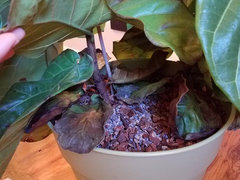
Thanks again TOC for all of this advice and help!
Len
Len M
6 years agoHi there Albany, I think we're doing as much as we need to be doing. Just don't over water your baby, unless you repotted into gritty mix, then in which case follow the advice TOC gave regarding watering after a repot into gritty mix. There is a wealth of information on this site so read up but the most important thing for us to do is wait patiently until our babies rebound from the shock of the transplant. And as Al has explained many times, a plant's timing is twice as slow as ours.
Good luck!
Len
robin98
6 years agoLen please take a moment to give it some water as soon as you're home. You can look at it more closely in the morning. The roots need to stay moist while it's recovering and from everything TOC is saying about gritty mix, it will be too dry by now. You said it was quite dry when you left and it's been another 3 days...
Len M
6 years agoYes you are absolutely right...I was worried about the same thing. I may have read somewhere that it's best to water plants in the morning instead of at night, which was the reasoning behind waiting 'til morning but I'd honestly rather water him as soon as I get home. I'm so glad you suggested this, Robin. I will do exactly that! I have another 3 & 1/2 hours of flying then racing home. I feel so anxious to get there already!! :-/
tropicofcancer (6b SW-PA)
6 years agoRobin/Len: The mix may not be too dry in 3 days at least for a normal well established plant. But for a newly potted plant it needs a bit more TLC in the beginning since its roots are yet to wrap around all the chunky particles.
Len: Some leaf drop after repot is normal. If you root prune a lot it is also a good idea to top prune or the plant will do it for you. Often it is the lower leaves that are sacrificed. I would not worry about it too much.
Using the jet setting for water is not a good idea since it damages the root hairs. Mist setting is much better although it takes longer. This is what I do. Water the plant well the day before in preparation for the surgery. After taking the plant out I will cut out the bottom third of the root ball with a saw if it is very dense or use pruning shears. Rake out the sides after that. Have a bucket of water ready and periodically dunk the root ball in the water as you work your way through the dirt. If the existing dirt is heavy compact mix I will keep the bottom supported with my hand while dunking in the water. This is to prevent the weight of the heavy wet soil tearing away the fine roots. When the root ball is clean and pruned I leave it in the bucket of water while I prepare my new pot. I have left plants overnight in the bucket if I run out of time - with no ill-effects.
Unless the plant is really small I always anchor the plant to the pot. To do this I use at least two wires tied to the bottom of the pot or the sides near the bottom. Then fill the pot to a certain level and position the plant and fill in the mix so that plant is in its desired position. Then use the wires to tie across the top of the root ball close to the stem. This prevents the plant from being accidentally uprooted since that is very easy to do after a big root pruning.Here are some pics:
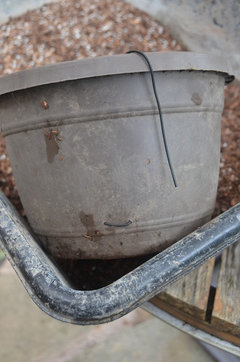
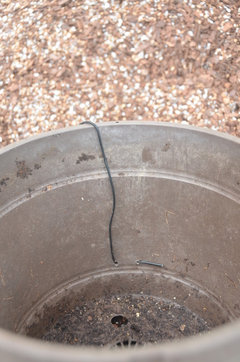
For tall and top heavy plants I use several guy wires - actually just twines - tied to the rim of the pot. After about a season the twines just disintegrate just enough for the plant to be established. This is a ficus carica - I think a brown turkey dug out of the ground in spring bare rooted and planted in 511 mix. You can may be even see the wire holding the stem near the soil line. I barely had any root ball to tie to. All this trouble so that the plant absolutely does not move while it is sending out new roots. It has figs now but probably will not ripen with all the cool weather we are having.
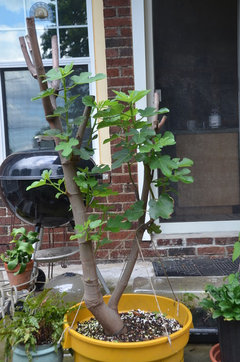
Len M
6 years agolast modified: 6 years agoTOC this was EXTREMELY helpful! Thank you for the detailed description of repotting. At least now I'll know how to do it going forward. I definitely need to anchor Fürguson down in the soil b/c he is now leaning so much that he's no longer standing straight up as he was when I repotted him. I'm also seeing his roots peeking out above the top of the soil and they are completely brown. :( His heaviness must have made him pull up out of the gritty mix b/c I know that they were completely covered when I repotted him. The soil was also, OVERLY dry when I got home. I feel I need to correct these 2 issues by repotting him back into his smaller grow pot and into the 5-1-1 mix that seems would be more forgiving with my schedule under the stressful circumstances of the repot. Robin, I know you said to just leave him be and don't repot again, but I think I'm doing just as much damage to leave these fine roots peeking out of this dry rocky soil :-(
I watered him last night exactly the way you both told me to, but I wonder, TOC if my gritty mix is so incredibly dry b/c I didn't soak the fir bark long enough beforehand? He was quite a bit worst when I got home last night than he was before I flew out 3 days ago. Many leaves on the bottom withered, hard, dry, brown & cracking. The top 2 new leaves shriveled & now browning. The trunks/stems look a little shriveled but are still kind of strong near the bottom and middle.
I'm just so sad and embarrassed that I created so much damage to such a healthy-looking, growing specimen of a tree all b/c I thought the gritty mix would be best for him with what I'd read about it. This mix, and perhaps even this type of plant, I feel, is for more advanced growers who know what they're doing. I, on the other hand, the super novice am failing miserably and I just want to help get him back on track :(
Here is what he's looking like today and the West facing window where he resides. Do you think it's too much sun for his state of health right now? I ask b/c I noticed that even his larger healthier looking leaves at the top are browning now around the edges and getting brown holes in some. Are they getting burned by the evening sun?
See how each stem is leaning heavily outward away from one another in the pot. There just weren't many roots to begin with and I barely even pruned any during the repot so I think the larger pot with all the drying soil isn't anchoring him and is doing an injustice as well.
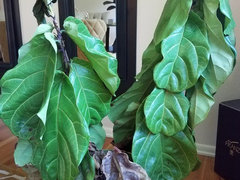 I can draw the sheers closed if need be to make the sunlight more filtered.
I can draw the sheers closed if need be to make the sunlight more filtered. Close up of one of his stems.
Close up of one of his stems. Browning and holes forming on larger upper leaves. What's causing This? Lack of proper water, or too much sun, or all that I've done wrong with the repot?
Browning and holes forming on larger upper leaves. What's causing This? Lack of proper water, or too much sun, or all that I've done wrong with the repot?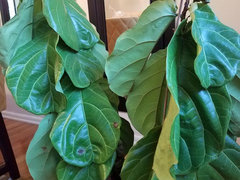
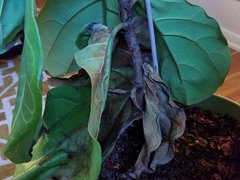 Severe browning, dry, dead-looking leaves underneath. Should I pluck these off? They still seem to be quite attached.
Severe browning, dry, dead-looking leaves underneath. Should I pluck these off? They still seem to be quite attached.
Also TOC/Robin, where do you think I should prune the top? (I'm thinking the top of the stem holding the two newest drooping leaves should be the only pruning I perform...what are your thoughts?) And will this force branching automatically even on a younger tree as mine? I was hoping to keep him in a straight vertical bush with lots of foliage from top to bottom similar to the tree in the below screenshot, but at the rate he's losing his bottom leaves I might be left with a tree like trunk in the end if back budding that low on the trunk doesn't occur. :(
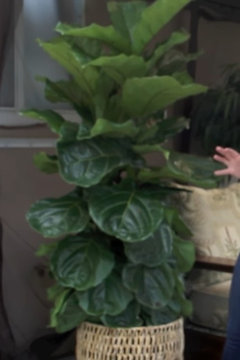
As always I appreciate all the time taken, help and advice you all are giving. I can't express enough how invaluable it has been.
Thankfully,
Len
Dave
6 years agolast modified: 6 years agoIf it were my tree, I too would repot into the 5:1:1 mix.
Gritty is obviously great, but the fact that you're gone for a few days at a time is going to constantly put the tree into drought response if it dries out too much.
Its looking pretty wilted and droopy up top. Keep the repot as quick and painless as you can. Try not to damage any roots and keep them moist during the repot and water thoroughly when you're done.
Anchor the tree after repotting to keep upright.
i grow all of my ficus in the 5:1:1 mix. While outside in the summer, they need water almost daily. In the winter, indoors, it's about every 4 days. But I also use supplemental lighting and get a decent amount of growth all winter, which equals more water usage.
Len M
6 years agoDave, thank you so much for your response! I'm going to do just that...keep it quick, painless and careful. It's quite hot here all this week and next (upper 80s-low 90s) so I think it's best I get him into the best growing environment now while there are still warm temps and plenty of sunshine to help with his healing.
Is this sunlight ok? Or should I draw the sheers behind the curtains closed to filter the sunlight & evening sunset heat until he heals?

Dave
6 years agolast modified: 6 years agoDoes the window get direct sun or just bright ambient light?
looks to be ambient. I'd prop it up on something and get it right in front of the glass.
id leave the shades open.
robin98
6 years agoLooks better than I thought! Still it is very sad to see those big leaves flopped down like that, you have my sympathy. You're right that the leaning is not doing it any good, so stabilise that asap.
Len, I recommended the 511 but still think it's risky to repot again now. He has been using energy reserves in the last two weeks trying to stay alive, and growing new root hairs (hopefully), but won't have had a chance yet to replenish these reserves (by photosynthesising). Not saying it will kill it, just might set it back even further. Let it re-establish now, get through winter, recharge in spring, repot when it's strongest at start of summer. It's not like the gritty is a bad mix for a few months, and it's winter water consumption will be low.
I'll shut up on that now and promise not to judge you either way! It's not like I always follow directions ;)
Right now it's still at the resuscitation phase, so keep the roots moist and put it somewhere bright and warm, out of direct sunshine and away from drafts for a couple weeks. When it improves you can give it lots more sun and let it dry out more in between waterings. So shift it or pull the curtain a bit if the sun is shining straight on it, just while it's recovering.
Also read a suggestion from Al to put dampened shredded sphagnum moss (not peat moss) loosely on the surface of the gritty mix to keep the upper levels, from drying so fast. As a temporary measure. Might help while you're away (or while you're getting your 511 ready ;)
Not meaning to ignore your leaf pruning questions, can get to that later, recovery is the first priority. Good luck!
Dave
6 years agoHonestly, if Len is gone for days at a time and can't properly water in the gritty mix, repotting would be a better option than having it be drought stressed weekly.
Len M
6 years agoWell gosh darnit, that's a good question. I haven't been home enough lately to know if my dining room gets direct sunlight when the sun is setting. If I had to guess I'd say it's more ambient sunlight b/c you can see the window is kind of shaded by the overhang off the back side of the house. Also, by the time the sun gets to the sunset point it's behind the trees back there. So we may get an hour at best, (if even at all) with the sun shining directly in through that window.
Dave
6 years agolast modified: 6 years agoI would leave the windows uncovered and prop the tree up right in front of the glass.
Len M
6 years agoSorry Robin, it seems my Houzz app gives me these responses and comments out of order so I'm just now seeing your reply.
You know how much I'm appreciating all of your help and advice, but if you could see just how dry this gritty mix is you'd want me to rescue Fürguson from the drought abuse I'm putting him through, too. I think Dave is absolutely right on this...if I repot as quickly as possible, being very careful not to damage the fine roots he'll likely heal quicker than if left in the gritty mix.
And I'm with you on the top pruning...let's just ignore that for now! ;-)
Len M
6 years agoOk, Dave will do.
Thanks to you both!!! If you don't mind, will you please keep the notifications on for this discussion, just in case I run into any major issues in the future? I won't bother you unless I'm really hung up on something. I'll post an update in about a week as not to inundate your Inboxes with my Fürguson's needs. I can use good common sense and judgement as well as read, read, read as much as I can to learn things I may eventually have questions about.
Thanks so much again & I pray you all are blessed!
Len :)
Dave
6 years agoI will keep an eye out for this thread. All of the notifications for anything on this forum go straight to my "social" folder on gmail and I never see them. I never set it up that way, it just does it.
chezron
6 years agoIt needs more sunlight. This plant wants more sunlight than is present in most homes. Also, I would recommend not cutting it anymore. Let it be.
User
6 years ago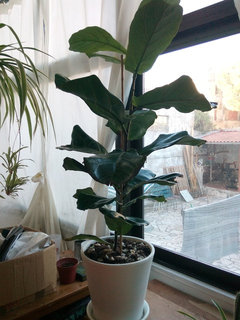
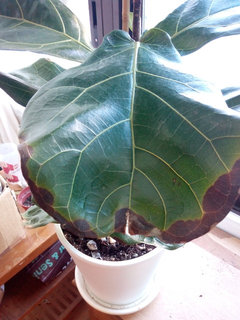
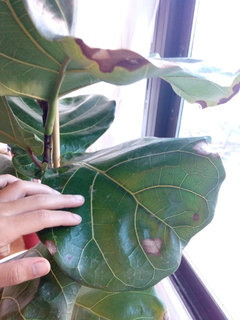
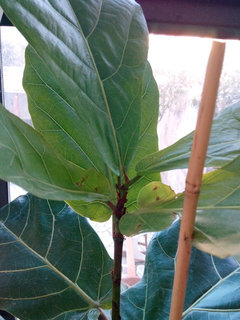
Hey guys, first of all, thanks to everyone that's helping. I've learned so much in the past two days. Specially Dave and Al...thank you teachers! :) So sorry about in the instrusion, I'm another one with fiddle leaf problems.
I think I was sold a sick FLF...the guys just told me that it was in direct light all day long, so I thought the brown spots were justified. Until I got home and realized the soil was really compact...really....compact and soggy...and loads of rocks on top, which probably wouldn't help.
So what I've did pretty fast, I went into despair...I've tried to repot it...and..of course I the roots just broke in half, and they were almost black and quite smelly...
I didn't have anything around other than regular soil with perlite, so I just moved the lyrata and the now shorter roots too a new dry vase with some brick pieces at the bottom and that soil...the soil it's very loose and didn't compressed whatsoever. Didn't watered since, two days now.
So after reading all of your kind info, Tomorrow I'm going too:1. Clean the remaining roots as well as I can without damaging it more..
2 .Repot, with 5:1:1 mix...Pine bark, Turf (should I?), Perlite; and some brick pieces in the bottom.
3. Water the lyrata once like flushing, right? And then again..
4. The bottom leaves are very very rigid almost like they are about to break, I've read one Al's comment about "the end of life" process of these leaves...Should I cut the last leave and put the trunk deeper so it forms new healthy roots? (if this makes any sense at all)
5. Pruning, I was thinking about cutting the top (last picture), but as the bottom leaves are so stiff, maybe they aren't able to produce that much "food" and I should keep the top one for now? (I'm I thinking stupid??)
6. The only I had to cover the pot was sawdust, with which I have been lucky in protecting my plants from pests and mould. Again...in a despair act..should I maintain this?
Can you help me please?? I'm based in Sintra,Portugal; very warm and humid location, actually humidity is a problem around here.
Any advice is most welcome! thanks!
User
6 years ago
 Forgot to upload these pictures, these are from today, it doesn't seem to be suffering more than it was before so...at least is still alive..You can see the bottom leaf that I want to cut, and the top which I don't know if I should.. thanks :)
Forgot to upload these pictures, these are from today, it doesn't seem to be suffering more than it was before so...at least is still alive..You can see the bottom leaf that I want to cut, and the top which I don't know if I should.. thanks :)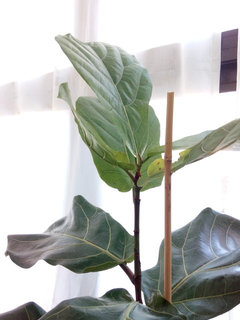
PS: Sorry about the photo surroundings..."never ending remodelling story"...as we all know ;)
tapla (mid-Michigan, USDA z5b-6a)
6 years agoHello, B. I saw your message and what you suggested isn't necessary. ;-) This is Makayla's thread, and generally it's considered inappropriate to piggyback on someone elses thread, but your questions are so 'on-topic' that I'm guessing Makayla won't mind. If she does, we'll need to move the conversation to another thread - maybe this one. Please do read the info the link takes you to.
When growing things, it's more about the journey than getting to a destination, so the only reason to despair is if the plant dies; and that bridge is better crossed when you get to it (for your peace of mind). I didn't just pull a platitude out of my back pocket and use it because it sounds good, I really think it's true. Growing, unless for profit, is about enjoying the nurturing experience.
As in the highest % of cases, the remedy/focus needs to be on restoring root health. Actually, when I say that, it really means restoring the health (vitality) of the entire plant, because you have to work hard at having an unhealthy plant with a healthy root system. There are a number of ways to go about restoring root health and o/a vitality, but by far, the easiest way is to make sure you're using a soil that allows you to water appropriately - so you CAN flush the soil any time it's necessary. An appropriate soil also makes fertilizing monkey-easy. With the right soil and an appropriate fertilizer, over-watering is nearly impossible and nutrition presents no worries, so all that's left is to make sure you don't forget to water, that the quality of your irrigation water isn't an issue, and things like temperature and other common sense cultural considerations are something the plant favors.
I'm unclear as to whether or not you have Turface? See your #2 above. Hopefully, we'll have the opportunity to exchange another round of thoughts before you get too deep into the repot. Please do take at least 1 picture of the roots after any work you do has been completed - it will provide the info needed to decide whether or not to reduce the plant's top mass.
Your turn.
Al
User
6 years agoJoy :) Thank you so much for answering e spending some time on this Al, I really appreciate it, thank you :)
"generally it's considered inappropriate to piggyback on someone elses thread"
oops, you're so right..Sorry Makayla! I didn't think at the time of the post to be honest, I had tones of other threads and articles open, and as a newbie just realized now what you mean...:) Anyway I'll move this to the other thread you've mentioned Al. Probably more people like me will benefit :)
Off to the other one!! thanks!


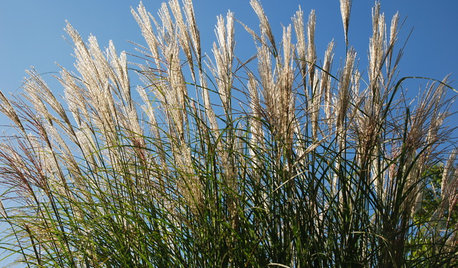
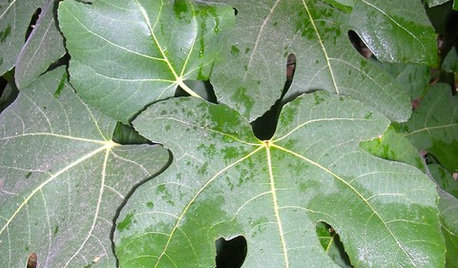



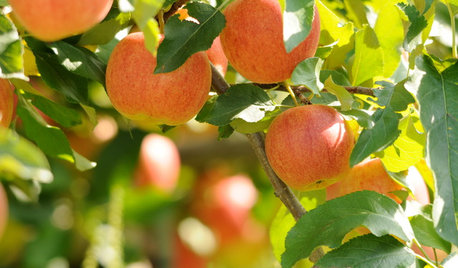

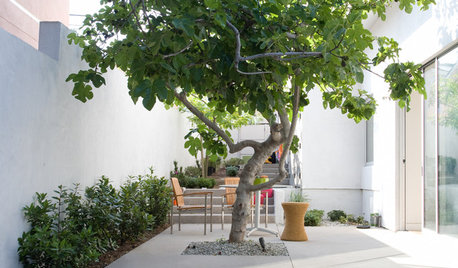







tapla (mid-Michigan, USDA z5b-6a)